Novotel Hoofddorp
Mulderblauw architecten
The architect as storyteller
‘The implementation of sustainable solutions in the hotel industry can extend beyond simply washing towels less frequently, encouraging guests to take shorter showers, or removing the key card to shut off electric lights. It might even reach so far that the positive results produced by the implementation of sustainable measures can give that little extra bit of luxury back to the guests. As an architect you really have to think about things like that.’ This is the opinion of Robert Mulder of the Dutch architecture firm Mulderblauw architecten, based in Zoeterwoude, that designed the exterior and the interior of the new 314-room Novotel hotel in Hoofddorp, the Netherlands.
Thinking in reverse
Mulder's firm, which is active in many different sectors, has specialized in the design of hotel interiors and exteriors. He is currently working together with Paul de Ruiter Architects on the exterior design and with design studio The Invisible Party on the interior design of the Hotel Amstelkwartier in Amsterdam. This hotel will become the most sustainable hotel in Europe. Mulder explains, ‘Hotels are semi-public buildings to which you can return and see whether and how applications are working. ‘I believe that a stay in a hotel should be a treat for the guest. You can't impose sustainability on them with some kind of Calvinistic austerity. Instead, you need to entice the guest and encourage their curiosity to explore the reasoning behind the architecture and design. This creates an inspiring assignment for us. Sustainability means more to us than thinking about energy savings or the smart use of materials. As a firm we believe that the human and social aspects of our designs are the most important and we are committed to these. This is our prime motivator. Sustainability flows forth from this commitment. Sustainability is about the future and what we leave behind for our children. It is about designing buildings that can be given different functions in the long term. It's about moving away from designing tailor-made buildings with a specific purpose towards buildings that can accommodate a variety of users. This type of reasoning means that we do not conceptualize from a building format and a design brief but that we approach a design primarily from its future value and then from the point of view of sustainable possibilities and principles. We think in reverse, as it were. It is a way of thinking that enables us to find new boundaries for each new concept.’
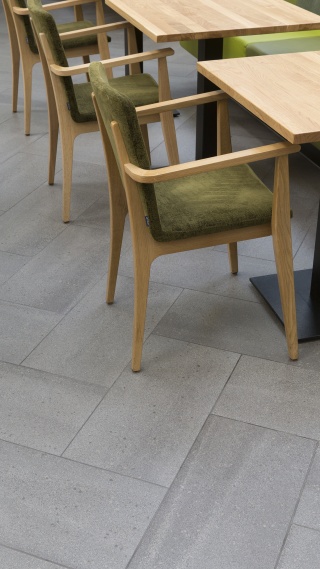
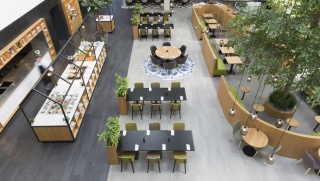
Working together means growing together
‘This also applied to the Novotel hotel in Hoofddorp that we completed at the end of 2015. We pushed the boundaries of its design, as we wanted to create a hotel that, in the future, could also be used as an office space or even as permanent housing with just a few modifications. In my opinion, this very flexibility as well as the use of materials, techniques, and the interior design are what determines its sustainability.' Graphic designer Miranda Ensink, who is partially responsible for interior design and façade design, adds, ‘Perhaps the term “designer” is somewhat misleading in this context, as you need to think in terms of functionality and not the end result. Only in this way can you be open to other perspectives and collaborations, create new things, and stimulate innovation in the design process.’ Mulder explains, ‘You see this approach reflected in our cooperation with Mosa. Mosa distinguishes itself not only through the sustainable production of its Cradle to Cradle tiles in the Netherlands but also by creating a space for dialogue. Mosa designers help us explore the possibilities every time we work together in a quest to produce something unique. This collaboration is important, as it makes the final design even better. Mosa understands what machines can do and what is possible with ceramic processes. That is an essential consideration, because as a designer you can't force an idea or fight against production processes. You need to respect them, take the answers to your questions seriously, test the possibilities together, and create better results.'
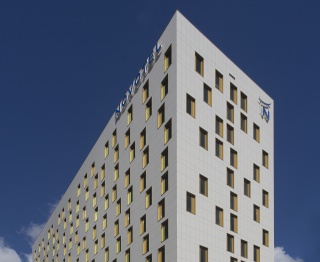
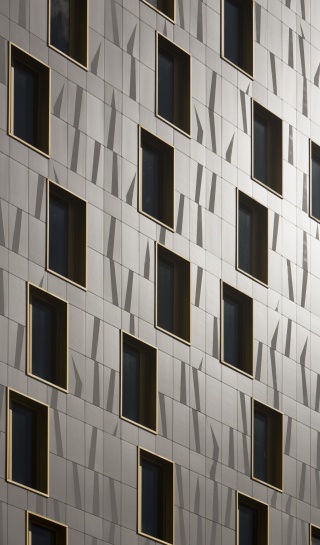
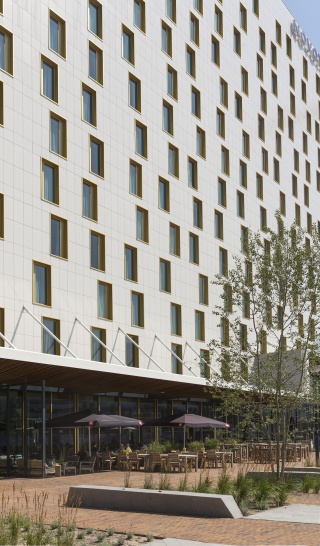
The power of ceramics
Mulder explains, ‘We wanted to design a light façade with a soft look for Novotel Hoofddorp that embodied the story of the natural surroundings. This would have been difficult to achieve if we had used metals or glass. Even ceramics were tricky, as you don't want the completed design to look like a bathroom. But ceramics allow you to decide on the colours and the look and feel of the surface and so shape the look of the whole to what you want it to be. We worked the concept of the reed beds along the canals of the Haarlemmermeer into the design and together with Mosa looked for a way of extending the reed-design all the way to the top of the building using tiles. As we investigated the possibilities of the production process together, the design became increasingly abstract. This design has been turned into a façade which creates a bold interplay between light and shadow through the alternation of matte and gloss surfaces. These tiles not only showcase their own print (high-gloss ink printed on stone matte glazing) but also reflect the actual landscape and Dutch skies above in a highly unique way.' Ensink continues, ‘This effect has turned out even better than what we had hoped for and makes every angle from which you look at the façade a captivating viewing experience each and every day.'
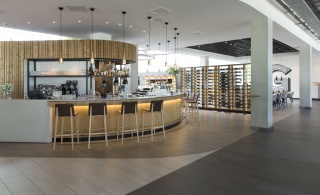
The importance of customer experience
Mulder explains, ‘In addition to using recyclable tiles in the façade and the hotel we also used top-quality insulation in the façade packages, green roofs, and column structures. Insulating in column structures reduces the mass, which reduces the weight of the building and contributes to a substantial reduction in the use of raw materials and energy. We also came up with a smart solution for the windows in the hotel rooms which was motivated by wanting to enhance the experience of the guest and to reduce heat and cold loss through the minimal use of glass. We designed vertical, narrow windows that have been recessed in the façade; perhaps not the most obvious choice, but due to their vertical positioning all the way down to the floor light can enter further into the hotel room. At the same time, the deeper placement of the windows in the façade creates more shadows when the sun is shining. This, in turn, means that the rooms do not get too warm and do not need to be cooled as much. Both effects are spectacular and are important to the experience of the guests. In this context I cannot emphasize enough that the human aspect has to be the most important principle of a design. This applies not only to hotel rooms but to any public space. You should not feel lost or lonely in such a space as an individual. As a result we have created well-placed, intimate spaces - islands - that overlap with one another and give the atrium a more human dimension. This embodies the essence of our designs. We could have designed a high-tech, cold hotel, but we ultimately believe that if a design doesn't have a softer human and social aspect, then we have failed.’
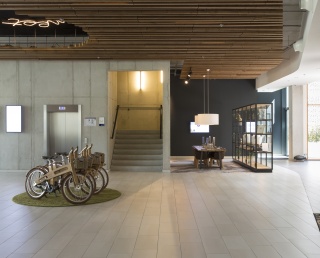
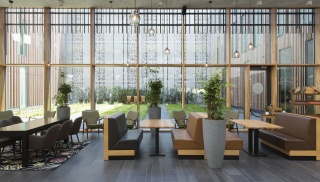
A sense of community
Mulder explains, ‘To enhance the social aspect of the design we have created a combination of tiled floors inside the atrium - which is light and inviting as a result of its transparent glass roof - that are interrupted by room dividers, carpets, and even wooden floors. This interplay creates contemporary islands that are still connected and stimulate interaction. People can pass the time comfortably in these spaces. Ensink adds, ‘We were able to use images of the collection of the Rijksmuseum in Amsterdam for inspiration for the carpets and wallpaper. We carefully selected a suitable graphic narrative for each space. We then enlarged, cut, reshaped, or projected these images in such a way that the printed effect is somewhat alienating yet still evokes a sense of recognition. Different perspectives are constantly created by playing around with the complete image. This is similar to what we planned with the façade. It inspires visitors to think.’ Mulder nods in agreement, and adds, ‘Just like our total design, this particular aspect adds a story to the plan of the client and to the building itself.' He concludes with a laugh, ‘In this sense, perhaps we are storytellers even more than we are designers.’
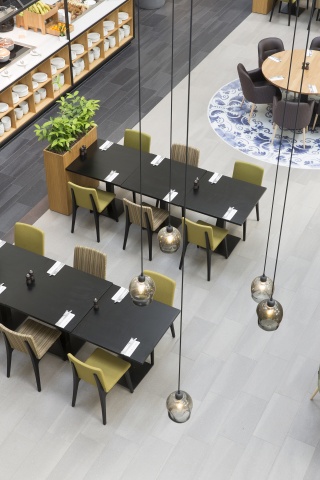
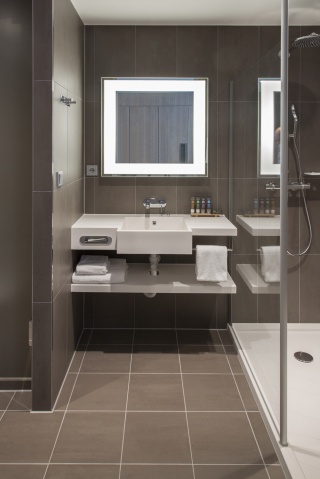
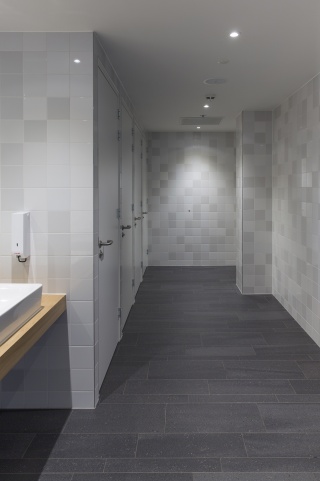
Project details
| Project: | Novotel |
| Architect: | Mulderblauw architecten |
| Location: | Hoofddorp (Netherlands) |
| Completion: | 2015 |
| Mosa series: | Custom design |
Inspiration
More information
We set high standards for the advice and support. This means that we actively aim for dialogue and that we are interested in what interests you. Do you have any questions about this project or would you like to discuss the options for your project?
Contact Mosa